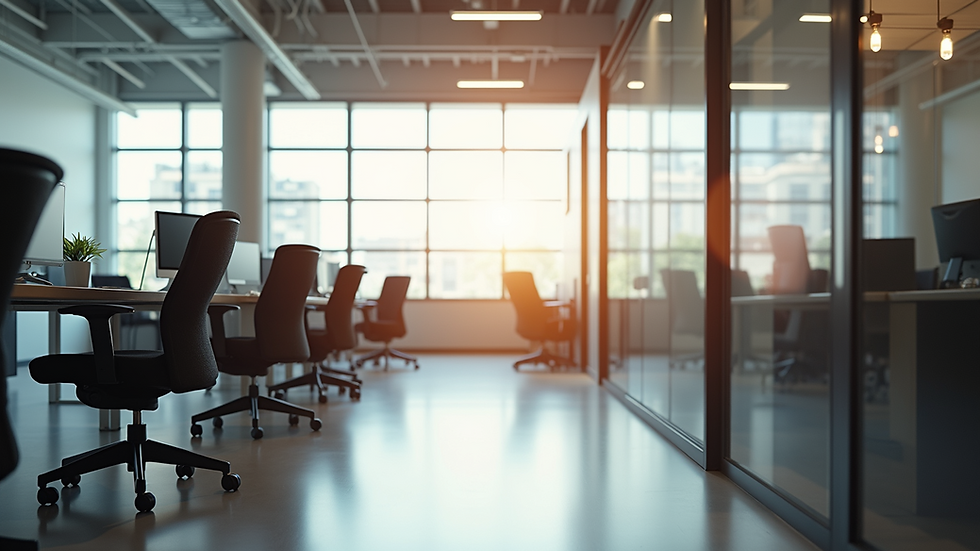Optimizing Office Layouts for Productivity and Style
- Design Expression

- Jul 10
- 3 min read
In today's fast-paced work environment, the design of an office isn't just about aesthetics; it's crucial for productivity, employee satisfaction, and even brand representation. The right office layout can foster creativity, reduce stress, and encourage collaboration. In this post, we will delve into the various aspects of optimizing office layouts, respecting both productivity and style.
Understanding the Importance of Office Design
The way an office is designed plays a significant role in how employees feel and perform. Research has shown that well-designed workplaces contribute to higher productivity and job satisfaction. For instance, a study by the International Facility Management Association found that an organized office has the potential to increase productivity by up to 20%.
When employees are surrounded by a pleasing environment, they are more likely to stay focused and work more efficiently. This connection between design and performance emphasizes the importance of thoughtful office design.

Key Elements of Effective Office Design
There are several key elements to consider when optimizing office layouts. Here are some strategies that can help create an efficient and stylish workspace:
1. Flexible Workspaces
Modern offices should promote flexibility. Incorporating adjustable furniture, such as standing desks and movable partitions, allows employees to customize their workspace based on their needs. This adaptability can lead to increased comfort and productivity. For instance, enabling employees to shift from collaborative spaces to quieter areas can help maintain focus during intensive tasks.
2. Natural Light and Ventilation
Natural light is crucial for maintaining employee well-being and productivity. Research indicates that offices with plenty of sunlight can enhance mood and energy levels. Open layouts with large windows not only provide natural light but also improve air quality with proper ventilation.
Employing glass walls or using lighter colors can enhance the flow of light throughout the office, creating a brighter environment.

3. Designated Collaboration Spaces
While open-plan offices are popular, they can sometimes hinder focus. Designating specific areas for collaboration is essential. These spaces can foster creativity and teamwork, allowing employees to brainstorm together without distraction.
Consider incorporating comfortable seating, whiteboards, and technology that supports group work. This way, employees can easily transition between focused work and collaborative tasks.
4. Incorporating Greenery
Adding plants to office spaces can significantly improve air quality and employee morale. Studies have shown that plants can reduce stress and increase productivity. Integrating greenery into office layouts can contribute to a more serene and inviting atmosphere.
Consider installing vertical gardens or simple planters throughout the workspace. The presence of plants also reflects a commitment to sustainability, aligning with modern values.
5. Personalization and Branding
Allowing employees to personalize their workspace can positively impact their mood and productivity. Simple measures, like providing them with options to decorate their desks, can create a sense of ownership and pride in their work environment.
Moreover, incorporating elements of your company’s branding into the office design can create a stronger connection between employees and the organizations. Using logos, color schemes, and even innovative artwork related to the brand can instill a sense of belonging and motivation.

Analyzing Space for Better Productivity
Effective office design requires analyzing how space is currently used. Conducting a space audit can help identify bottlenecks, underused areas, and opportunities for improvement. Engage your team in discussions to learn their needs and preferences.
By understanding which areas are most frequently used and where employees feel most comfortable, you can develop a tailored layout that promotes productivity while also reflecting your company's culture.
The Balance Between Style and Function
While it’s essential to focus on functionality, the style of the office is equally important. An aesthetically pleasing environment can make a significant impact on employee satisfaction and brand perception.
Striking a balance between style and function requires careful consideration of colors, materials, and overall design themes. Choosing the right furniture, artwork, and decorative elements can help convey your organization’s values and ethos.
Incorporating aspects of commercial space design can elevate your office environment, connecting form with function in a way that resonates with both clients and employees.
Final Thoughts on Office Layout Optimization
Creating an optimized office layout is not simply about accommodating teams, but nurturing a positive work culture. By investing time and resources into thoughtful design, companies can reap the benefits of improved productivity and employee happiness.
Prioritizing flexibility, natural light, designated collaboration areas, greenery, and personal expression in the office will pay off in the long run. So take a step back, evaluate your current office design, and consider how small changes can lead to big improvements.
In a world where remote work and hybrid models are becoming commonplace, ensuring employees feel connected to their workspace is more important than ever. Take the leap into thoughtful office design; it might just spark the creativity you've been looking for.




Comments